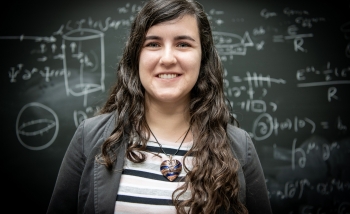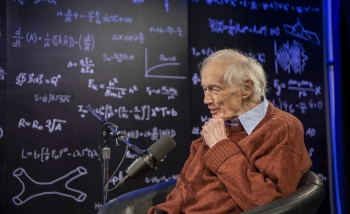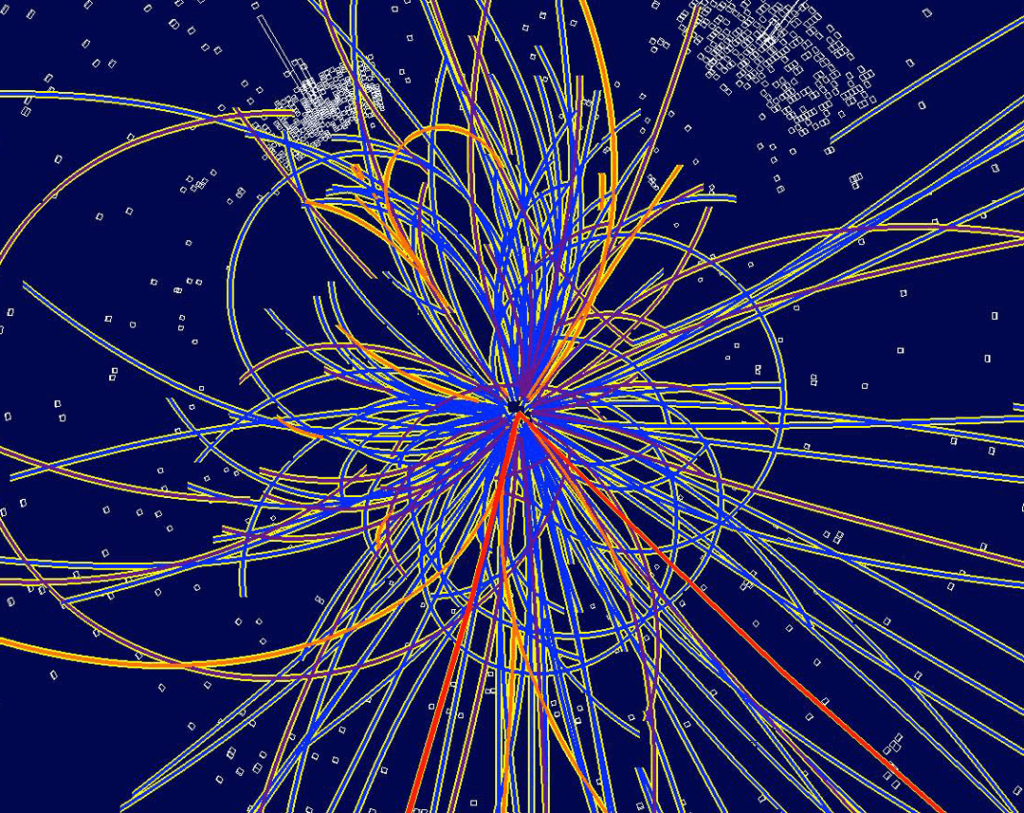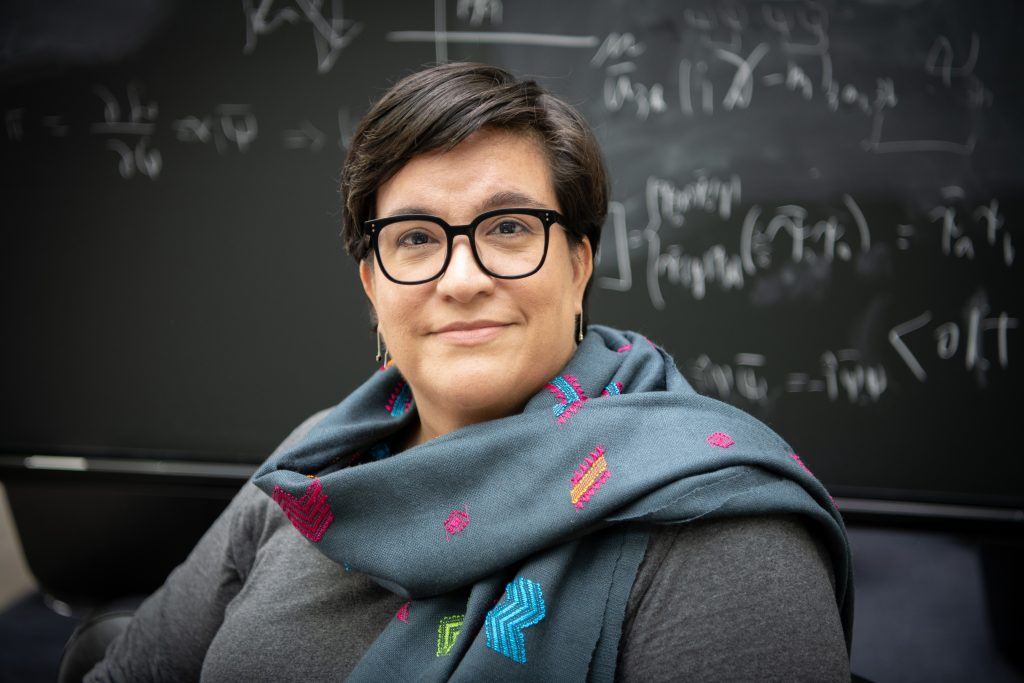In its very first moments, the universe looked significantly different than the galaxies, stars, and planets we see today. All matter and energy as we know it was squeezed to a density so thick and so hot that ordinary matter – particles like neutrons and protons – couldn’t yet exist.
In its place, there was only plasma. For just a few microseconds, the entire universe was made of the stuff. It was a special kind of plasma, composed of deconfined quarks and gluons: tiny particles that, when they finally spread out enough to cool down, would become the building blocks of atoms.
Understanding the nature of this quark-gluon plasma in the early universe could help us refine the Standard Model of particle physics – the theory that describes all the fundamental forces in the universe, with the exception, so far, of gravity – and help us explain why matter itself looks and acts as it does.
That’s the research focus for Malena Tejeda-Yeomans, a professor of physics at Universidad de Colima, Mexico, who is visiting Perimeter this fall as a Simons Emmy Noether Fellow. While here, she plans to collaborate with Perimeter Faculty member Freddy Cachazo to refine the mathematical tools used to study quark-gluon plasma and its possible implications for particle physics and the strong nuclear force: the force that binds atomic nuclei together.
Particle colliders, neutron stars, and the big bang
“The motivation is to recreate the conditions of the early universe,” says Tejeda-Yeomans. Those conditions can be replicated in several ways, including through computer simulations or by colliding heavy ions using particle colliders.
In ordinary circumstances, quarks and gluons are confined within hadrons – particles like neutrons and protons – and cannot be observed on their own. This confinement process is described by a theory called quantum chromodynamics. But in the extreme conditions of the early universe, that confinement is broken.
“Since they are very cramped together, in very warm, hot conditions, they behave more like a fluid. So you have to change your approach and describe this thing as a plasma,” explains Tejeda-Yeomans.
Of particular interest to Tejeda-Yeomans is understanding what happened as the universe cooled and the quarks and gluons began to congeal: “What makes them clump together or confine into all the hadrons that we know of? Why don't they clump together in other ways, rather than the ways that we see? This process of ‘hadronization’, where matter that is deconfined becomes confined, is key to understanding the early universe.”
There are a variety of experiments that try to artificially recreate quark-gluon plasma via heavy ion collisions, allowing scientists to study its behaviour up close. High energy experiments, like ALICE (A Large Ion Collider Experiment) at CERN’s Large Hadron Collider, explore the quark-gluon plasma at very high temperatures but very low densities.
Conversely, there are experiments that create the plasma at lower temperatures and higher densities. Current and future experiments of this nature include the Relativistic Heavy Ion Collider and the Electron-Ion Collider at Brookhaven National Laboratory; the Facility for Antiproton and Ion Research and the GSI Helmholtz Centre for Heavy Ion Research; and the Multi-Purpose Detector at the Nuclotron-based Ion Collider facility.
Tejeda-Yeomans suggests that these high-density experiments are particularly illuminating because they mimic the naturally occurring quark-gluon plasma found in the cores of neutron stars.
Neutron stars – the ultra-dense cores of collapsed supergiant stars – are the only place in the current universe where researchers have found the presence of naturally occurring quark-gluon plasma. Much remains to be learned about neutron stars, and doing so might help us understand more about the early universe.
“There are a lot of people who do astrophysical models of what happens inside stars, and they have observables from the way the stars shine, their periods, etc.,” says Tejeda-Yeomans. From these observables, astrophysicists have long sought to determine a neutron star’s equation of state – that is, a description of how physical conditions such as temperature, pressure, and internal energy affect the state of matter inside the star.
Comparing notes between astro, particle, and nuclear physicists might yield new insights for all parties about how quarks and gluons behave under extreme conditions. “How does that equation of state educate me about the system that I’m creating in heavy ion collisions on Earth in a controlled experiment?” asks Tejeda-Yeomans. “It's very exciting, and I think it's incredible that we as a community can do all these things right now.”
Tejeda-Yeomans’ own expertise is in quantum chromodynamics. Cachazo, meanwhile, has expertise with various mathematical tools that offer yet another potentially fruitful line of inquiry by looking closely into the mathematical formalism that lies behind the behaviour of quark-gluon plasma. By bringing all these distinct skill sets together, they aim to make progress that neither party could achieve on their own.
The building blocks of matter
Tejeda-Yeomans’ path to becoming a physicist was built on the desire to discover the inner workings of the world around her. As a young girl, she loved to take things apart to see how they operated.
She remembers helping her dad open up and fix the television; making models of molecules out of sticks and clay; and watching her parents, who were both high school chemistry teachers, preparing lectures for classes. The notion of combining atoms to make different and more complicated molecules ignited her imagination.
In university, she signed up for an engineering degree, following in the footsteps of some of her family members. After a year, she switched to physics after being captivated by the idea that mathematics could reveal underlying truths about the world.
She remembers excitedly wondering, “Can I do a calculation where, on my own, I realize something about the nature of things – about how matter is created? It was a very abstract thing. I didn't have a particular idea what I wanted to do.” But when she discovered particle physics, she knew it was meant for her.
After finishing her undergraduate studies and obtaining her PhD at Durham University in the UK, she took up a postdoc at Stony Brook University in New York and then a faculty position at Universidad de Sonora, before landing her current role as a full-time researcher and professor at Universidad de Colima. Tejeda-Yeomans has made a career out of trying to understand the inner workings of matter. She also teaches undergraduate students, some of whom may well become the next generation of particle and nuclear physicists.
Inspiring future scientists
Tejeda-Yeomans is one of several researchers set to visit Perimeter under the Simons Emmy Noether Fellowship program this year. Supported by the Simons Foundation, the program provides support to talented early- and mid-career women and underrepresented groups in physics. Fellowship recipients can spend up to a year in Perimeter’s unique research environment, relieved of administrative and teaching duties, allowing them the freedom and support to perform intensive research.
Tejeda-Yeomans is making the most of the opportunity. “The Emmy Noether Fellowship came at a point in my life where I was craving the space – the mental space and the physical space – to pursue many aspects of fundamental physics that I couldn't have done in my home university because research funding is scarce in Mexico for these kinds of topics,” she says.
“That, plus the fact that the Emmy Noether Fellowship comes with an opportunity to bring students and family members, makes it the perfect opportunity to go back to the fundamental roots of my training and do some projects that I wouldn't have been able to do back home.”
Being able to bring her undergraduate students to Perimeter this summer was especially important to Tejeda-Yeomans. Here, they could be immersed in the Institute’s research environment, which she hoped would inspire them to “see themselves as part of a worldwide endeavour.” It was also an opportunity to give them a taste of what a future career in physics might look like.
The visiting students, Geraldine Cabrera and Ulises Zarate, thoroughly appreciated the opportunity. Zarate said at the end of their visit: “We’re taking with us the experiences, knowledge, good memories and friendships acquired throughout almost a month [at Perimeter]. It was a unique opportunity and experience that I am really glad I was part of.”
Tejeda-Yeomans is keenly aware that she is uniquely positioned to be a role model to young scientists – especially women – in Mexico and around the world. While visiting Perimeter, she has been thinking carefully about how she can have the most impact. “How can my being here create or open up a path for more women who are doing theoretical work in Latin America?”
Building bridges
The connections and networks built during research visits like this one are powerful incubators for collaboration. Together with Cachazo, Tejeda-Yeomans is organizing a seminar series with University of Waterloo Associate Professor Karen Yeats this fall.
“I think I can contribute by giving some phenomenological perspective to what they're doing theoretically,” says Tejeda-Yeomans. Phenomenology in physics refers to making predictions by applying theories of particle interactions to experimental data.
While Yeats is an expert on the mathematical properties of Feynman diagrams (tools that describe particle interactions), and Cachazo is an expert in amplitudes in several different quantum field theories, Tejeda-Yeomans’ work involves both calculating amplitudes and using Feynman diagrams for phenomenological applications in various experiments. The opportunities for knowledge-sharing between them are clear and exciting.
“Ideally, we would like this forum to foster new avenues in connection to phenomenology relevant for current and future experiments, where interacting matter-radiation under extreme conditions is probed,” Tejeda-Yeomans says of the seminar series.
By bringing together graduate students, postdocs, and researchers with a wide breadth of perspectives, the group hopes to spark new insights and “create a dialogue that allows some sort of cross-fertilization of these fields.”
About PI
Perimeter Institute is the world’s largest research hub devoted to theoretical physics. The independent Institute was founded in 1999 to foster breakthroughs in the fundamental understanding of our universe, from the smallest particles to the entire cosmos. Research at Perimeter is motivated by the understanding that fundamental science advances human knowledge and catalyzes innovation, and that today’s theoretical physics is tomorrow’s technology. Located in the Region of Waterloo, the not-for-profit Institute is a unique public-private endeavour, including the Governments of Ontario and Canada, that enables cutting-edge research, trains the next generation of scientific pioneers, and shares the power of physics through award-winning educational outreach and public engagement.
You might be interested in


What is it like to be part of an underrepresented gender identity in physics?
February 9, 2024


